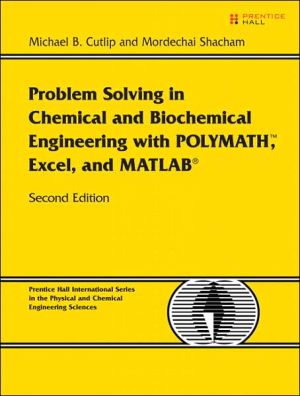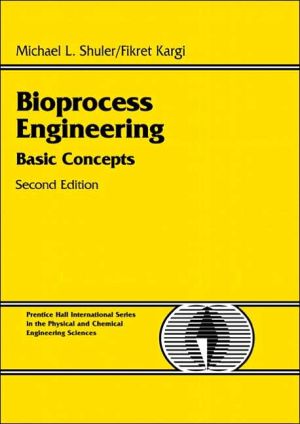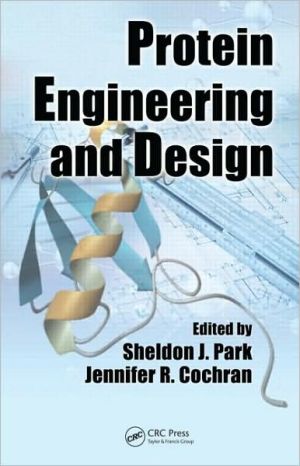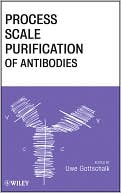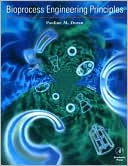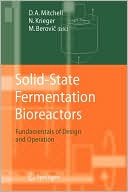Problem Solving in Chemical and Biochemical Engineering with POLYMATH, Excel, and MATLAB
Problem Solving in Chemical and Biochemical Engineering with POLYMATH™, Excel, and MATLAB®, Second Edition , is a valuable resource and companion that integrates the use of numerical problem solving in the three most widely used software packages: POLYMATH, Microsoft Excel, and MATLAB. Recently developed POLYMATH capabilities allow the automatic creation of Excel spreadsheets and the generation of MATLAB code for problem solutions. Students and professional engineers will appreciate the ease...
Search in google:
Problem Solving in Chemical and Biochemical Engineering with POLYMATH™, Excel, and MATLAB®, Second Edition, is a valuable resource and companion that integrates the use of numerical problem solving in the three most widely used software packages: POLYMATH, Microsoft Excel, and MATLAB. Recently developed POLYMATH capabilities allow the automatic creation of Excel spreadsheets and the generation of MATLAB code for problem solutions. Students and professional engineers will appreciate the ease with which problems can be entered into POLYMATH and then solved independently in all three software packages, while taking full advantage of the unique capabilities within each package. The book includes more than 170 problems requiring numerical solutions.This greatly expanded and revised second edition includes new chapters on getting started with and using Excel and MATLAB. It also places special emphasis on biochemical engineering with a major chapter on the subject and with the integration of biochemical problems throughout the book.General Topics and Subject Areas, Organized by ChapterIntroduction to Problem Solving with Mathematical Software PackagesBasic Principles and CalculationsRegression and Correlation of DataIntroduction to Problem Solving with ExcelIntroduction to Problem Solving with MATLABAdvanced Problem-Solving TechniquesThermodynamicsFluid MechanicsHeat TransferMass TransferChemical Reaction EngineeringPhase Equilibrium and DistillationProcess Dynamics and ControlBiochemical EngineeringPractical Aspects of Problem-Solving CapabilitiesSimultaneous Linear EquationsSimultaneous Nonlinear EquationsLinear, Multiple Linear, and Nonlinear Regressions with Statistical AnalysesPartial Differential Equations (Using the Numerical Method of Lines)Curve Fitting by Polynomials with Statistical AnalysisSimultaneous Ordinary Differential Equations (Including Problems Involving Stiff Systems, Differential-Algebraic Equations, and Parameter Estimation in Systems of Ordinary Differential Equations)The Book's Web Site (http://www.problemsolvingbook.com)Provides solved and partially solved problem files for all three software packages, plus additional materialsDescribes discounted purchase options for educational version of POLYMATH available to book purchasersIncludes detailed, selected problem solutions in Maple™, Mathcad®, and Mathematica™
Book Overview \ This book provides extensive problem-solving instruction and suggestions, numerous examples, and many complete and partial solutions in the main subject areas of chemical and biochemical engineering and related disciplines. Problem solutions are clearly developed using fundamental principles to create mathematical models. An equation-oriented approach that enables computer-based problem solving on personal computers is utilized. Efficient and effective problem solving is introduced employing numerical methods for linear equations, nonlinear equations, ordinary and partial differential equations, linear and nonlinear regressions, and polynomial curve fitting. Basic to advanced problem solving is covered utilizing a novel integrated approach with three widely used mathematical software packages: POLYMATH, Excel, and MATLAB. Readers may choose to focus on one or more of these software packages or utilize another mathematical software package.\ The book and a dedicated web site (http://www.problemsolvingbook.com) furnish all necessary problem information, software files, and additional enrichment materials. For advanced applications, unique software tools are provided for solving complex problems such as parameter estimation in dynamic systems and solution of constrained systems of algebraic equations.\ Intended Audience\ This book is intended for individuals who are interested in solving problems in chemical and biochemical engineering and in related fields by using mathematical software packages on personal computers. It can serve as a textbook for students in conjunction with college- and university-level courses, and it can be a companion reference book for individual students. For professionals, it can be an invaluable reference book that also allows extensive self-study in problem solving using the most widely used software packages.\ Background\ Prior to the introduction of the personal computers and mathematical software packages in the early 1980's, desktop calculations for engineering problem solving were mainly carried out with hand-held calculators. Sometimes mainframe computers were utilized, which required source code programming. Since then the emphasis has gradually moved to computer-based (or computer-enhanced) problem solving or CBPS on desktop or notebook computers. By the time the first edition of this book was published in 1999, it became evident that CBPS can be a very important, or possibly the most important, application of the computer in scientific and engineering education and in industrial practice.\ The first edition of this book provided examples to the use of CBPS in core chemical engineering subject areas using the POLYMATH software package. Shortly after the publication of the first edition, we carried out several comparison studies in order to determine what types of software packages should be included in the "toolbox" of the engineering student and the practicing engineer that would enable the effective and efficient solution of practical problems. We arrived at the conclusion that three types of software are needed. There is a need for a numerical problem solver, such as POLYMATH, that accepts the model equations close to their mathematical forms and provides their numerical solution with very minimal user intervention. Additionally, there is also a need to be able to use spreadsheet software, such as Excel, because of its wide use in business and industry. Software like Excel is also used for the organization and presentation of information in tabular and graphical forms and for database management-related operations. Software packages that support programming, such as MATLAB, are needed to implement algorithms which are required in graduate research and advanced mathematics, programming, control, and numerical analysis courses.\ It is increasingly important for today's engineering student and forward-looking engineering professionals to be proficient in the use of several software packages, and thus we greatly expanded the book so that it now includes solutions in Excel and MATLAB, in addition to POLYMATH. New problems have been introduced that demonstrate how the special capabilities of each of these packages can best be utilized for efficient and effective problem solving.\ The POLYMATH Numerical Computation Package\ The POLYMATH package provides convenient solutions to most numerical analysis problems, including the problems that are presented in this book. We authored and published the first PC version of POLYMATH in 1984, and it has been in use since then in over one hundred universities and selected industrial sites world wide. The version available at the time of the publication of the book, POLYMATH 6.1, was released in 2006. This package contains the following programs:\ Ordinary Differential Equations Solver\ Nonlinear Algebraic Equations Solver\ Linear Algebraic Equations Solver\ Polynomial, Multiple Linear, and Nonlinear Regression Program\ The programs are extremely easy to use, and all options are menu driven. Equations are entered in standard form with user-defined notation. Results are presented in graphical or tabular form. A sophisticated calculator and a general unit conversion utility are available within POLYMATH.\ The new and unique capability of the latest POLYMATH to automatically export any problem to Excel and MATLAB with a single keypress is extensively utilized within this book. Automatic export to Excel includes all intrinsic functions and logical variables. A POLYMATH ODE_Solver Add-In is included for solving ordinary differential equations in Excel. Upon export to MATLAB, the equations are ordered in the computational sequence, the intrinsic functions and logical statements are converted, and a MATLAB function is generated. Template files to run the functions are available in the HELP section of POLYMATH or from the book's web site.\ Current information on the latest POLYMATH software is available from http://www.polymath-software.com.\ Many departments and some universities have obtained site licenses for POLYMATH. These licenses allow installation in all computer labs, and individual copies can be provided to all students, faculty and staff for use on personal computers. Detailed information is available from academic@polymath-software.com\ Use of This Book\ This book is intended to serve as a companion text for the engineering student, the faculty instructor, or the practicing engineer. The instructions in the practical use of mathematical software package on representative problems from most chemical and biochemical engineering subject areas provide direct insight into problem setup and various practical aspects of numerical problem solving. For the undergraduate student at the early stages of his/her studies, the book can serve as the textbook for learning to categorize the problems according to the numerical methods that should be used for efficient and effective solutions. It provides basic instruction in the use of three popular and widely used software packages: POLYMATH, Excel, and MATLAB. Emphasis is on setting up problems and effectively obtaining the necessary solutions.\ In addition to providing general numerical solving capabilities, the text gives problems in most subject areas so that it can serve as a reference book in most courses, as it provides example problems that can be illustrative of problems that may be assigned in the various courses. The book also provides help with problem solving in advanced level for problems often encountered in undergraduate and graduate research such as nonlinear regression, parameter estimation in differential systems, solving two-point boundary value problems and partial differential equations, constrained equation solving, and optimization.\ For the practicing engineer, the book serves as resource book in computer-based problem solving. It provides a solid foundation in problem solving and can develop basic and advanced skills in the utilization of spreadsheets. Practical problems illustrate various problem solving approaches that can be implemented for problem formulation, problem solving, analysis, presentation of results, and documentation. Of particular interest is the coverage of the correlation and regression of data with statistical analysis. All of the book's problems can be solved with the Excel spreadsheet software that is widely used in industry.\ Engineering faculty can use the book to introduce numerical methods into an individual course, a sequence of courses, or an entire departmental curriculum. This book provides supplementary problems that can be assigned to students in order to introduce numerical problem solving which is avoided in most textbooks. Many of the problems can be easily extended to open-ended problem solving so that critical thinking skills can be developed. The numerical solutions can be used to answer many "what if" type questions so that students can be encouraged to think about the implications of the problem solutions. The book can also be used as a companion textbook for an introductory computer programming course or a comprehensive course in numerical analysis.\ Book Organization\ All the chapters of the book, except the introductory Chapter 1, are built around problems that serve to provide practical applications in a particular subject area. Most of the problems presented in the book have the same general format for the convenience of the reader. The concise problem topic is followed by a listing of the engineering concepts demonstrated by the problem. Then the numerical methods utilized in the solution are indicated just before the detailed problem statement. Each of the problems presents the detailed equations and parameter values that are necessary for solution, including the appropriate units in a variety of systems, with Systeme International d'Unites (SI) being the most commonly used. Because of the wide variety of problems posed in this book, the notation used has been standardized according to one of the major Prentice Hall textbooks in the various subject areas whenever possible. Physical properties are either given directly in the problem or in the appendices.\ The book is divided into two parts. In the first part, which includes the first six chapters, subjects of general interest are presented, some on an introductory level and some on an advanced level. In Chapter 1, Introduction, the history of CBPS is briefly reviewed and guidelines are provided for categorizing problems according to the numerical techniques that should be used for their solution. Chapter 2, Basic Principles and Calculations, serves a dual purpose. The chapter introduces the reader to the subject material that is typically taught in a first chemical engineering course (in most universities called Material and Energy Balance, or Stoichiometry). Additionally, this chapter demonstrates the use of POLYMATH for solving simple problems belonging to the main categories discussed in the book, namely single nonlinear algebraic equations, systems of linear algebraic equations, linear and polynomial regression, and systems of ordinary differential equations (ODEs).\ In Chapter 3, Regression and Correlation of Data, the application of POLYMATH for analysis and regression of data using advanced statistical techniques is demonstrated. Chapter 4, Problem Solving with Excel, introduces the reader to the engineering and scientific problem solving capabilities of Excel using problems belonging to the same categories as in Chapter 2. The automatic export capabilities of POLYMATH to Excel are discussed. More advanced topics such as solution of systems of nonlinear algebraic equations (NLEs) and optimization with constraints (nonlinear programming) are also presented.\ In Chapter 5, Problem Solving with MATLAB, MATLAB is used to solve the problems presented in Chapter 4. The capability of POLYMATH to automatically generate MATLAB m-files are presented and provided templates for MATLAB problem solutions are demonstrated and utilized. In Chapter 6, Advanced Techniques in Problem Solving, the problem solutions deal with advanced topics such as two-point boundary value problems, systems of differential-algebraic equations, partial differential equations, and parameter estimation in systems of differential equations.\ The second part of the book (Chapters 7 through 14) is organized according to the particular subject areas such as Thermodynamics (Chapter 7), Fluid Mechanics (Chapter 8), and so forth. The content of these chapters is presented in the typical order of coverage in college or university-level courses.\ New Content in the Second Edition\ The contents of the book were almost doubled by adding six new chapters to the eight chapters of the first edition. The introductory Chapter 1 was added in order to help the reader in a very critical step of the problem solving—the characterization of the problem in terms of the solution method that has to be used.\ After studying and verifying the importance of various software packages in effective and efficient problem solving, the two chapters dealing with the use of Excel and MATLAB were added. These chapters also introduce the new capability of the POLYMATH software to automatically convert a problem solution into Excel worksheets and MATLAB m-files. This considerably shortens the learning curve associated with the initial use of these packages.\ Since the first edition was published, biochemical engineering has gained importance and is now being taught in most colleges and universities. The new biochemical engineering chapter and selected problems in other chapters provide a wide selection of problems in this important subject area. New chapters on "Phase Equilibria and Distillation" (Chapter 12) and "Process Dynamics and Control" (Chapter 13) have been added.\ Companion Web Site\ Readers of the book are encouraged to make full use of the companion web site that will be maintained and extended by the book's authors. This web site, http://www.problemsolvingbook.com/ , enables downloads of program files which are used in the various book chapters for the three software packages: POLYMATH, Excel, and MATLAB. Additional educational problems, learning resources, corrections and updates to this book, and new materials are provided.\ The web site also allows book owners to purchase and immediately download the latest POLYMATH software at significant discounts from the already highly discounted POLYMATH Educational version software. This enables book users to have the very latest software at very reasonable cost.\ Instructors who are using the book have special access to all problems as well as substantial educational and enrichment materials through the companion web site. This include suggestions as to the book use in individual courses, sequences of courses, and throughout a departmental curriculum. Details about this access are provided in Chapter 1 from the authors.\ Chemical and Biochemical Engineering Departments\ Academic departments are encouraged to consider adopting this book during the first introductory course in chemical and/or biochemical engineering and then utilizing the book as a supplement for many of the following courses in the curriculum. This allows an integrated approach to the use of numerical methods throughout the curriculum. This approach can be helpful in satisfying the ABET requirements for appropriate computer use in undergraduate studies.\ A first course in numerical methods can also utilize many of the problems as relevant examples. In this application, the book will supplement a standard numerical methods textbook. Students will find the problems in this book to be more interesting than the strictly mathematical or simplified problems presented in many standard numerical analysis textbooks.
Prefacexv Chapter 1 Problem Solving with Mathematical Software Packages 1 1.1 Efficient Problem Solving—The Objective of This Book 11.2 From Manual Problem Solving to Use of Mathematical Software 21.3 Categorizing Problems According to the Solution Technique Used 51.4 Effective Use of This Book 101.5 Software Usage with This Book 121.6 Web-Based Resources for This Book 13Chapter 2 Basic Principles and Calculations15 2.1 Molar Volume and Compressibility Factor from Van Der Waals Equation 152.2 Molar Volume and Compressibility Factor from Redlich-Kwong Equation 192.3 Stoichiometric Calculations for Biological Reactions 202.4 Steady-State Material Balances on A Separation Train 232.5 Fitting Polynomials and Correlation Equations to Vapor Pressure Data 252.6 Vapor Pressure Correlations for Sulfur Compounds in Petroleum 332.7 Mean Heat Capacity of N-Propane 342.8 Vapor Pressure Correlation by Clapeyron and Antoine Equations 362.9 Gas Volume Calculations Using Various Equations of State 382.10 Bubble Point Calculation for an Ideal Binary Mixture 412.11 Dew Point Calculation for an Ideal Binary Mixture 442.12 Bubble Point and Dew Point for an Ideal Multicomponent Mixture 452.13 Adiabatic Flame Temperature in Combustion 462.14 Unsteady-State Mixing in a Tank 492.15 Unsteady-State Mixing in a Series of Tanks 522.16 Heat Exchange in a Series of Tanks 53References 56Chapter 3 Regression and Correlation of Data57 3.1 Estimation of Antoine Equation Parameters Using Nonlinear Regression 573.2 Antoine Equation Parameters for Various Hydrocarbons 613.3 Correlation of Thermodynamic and Physical Properties of N-Propane 623.4 Temperature Dependency of Selected Properties 723.5 Heat Transfer Correlations from Dimensional Analysis 733.6 Heat Transfer Correlation of Liquids in Tubes 793.7 Heat Transfer in Fluidized Bed Reactor 803.8 Correlation of Binary Activity Coefficients Using Margules Equations 813.9 Margules Equations for Binary Systems Containing Trichloroethane 863.10 Rate Data Analysis for A Catalytic Reforming Reaction 873.11 Regression of Rate Data-Checking Dependency Among Variables 893.12 Regression of Heterogeneous Catalytic Rate Data 933.13 Variation of Reaction Rate Constant with Temperature 943.14 Calculation of Antoine Equation Parameters Using Linear Regression 95References 100Chapter 4 Problem Solving with Excel 101 4.1 Molar Volume And Compressibility From Redlich-Kwong Equation 1014.2 Calculation Of The Flow Rate In A Pipeline 1104.3 Adiabatic Operation Of A Tubular Reactor For Cracking Of Acetone 1194.4 Correlation Of The Physical Properties Of Ethane 1284.5 Complex Chemical Equilibrium By Gibbs Energy Minimization 144References 152Chapter 5 Problem Solving with MATLAB 1535.1 Molar Volume and Compressibility from Redlich-Kwong Equation 1535.2 Calculation of the Flow Rate in a Pipeline 1655.3 Adiabatic Operation of a Tubular Reactor for Cracking of Acetone 1735.4 Correlation of the Physical Properties of Ethane 1825.5 Complex Chemical Equilibrium by Gibbs Energy Minimization 195Reference 202Chapter 6 Advanced Techniques in Problem Solving 203 6.1 Solution of Stiff Ordinary Differential Equations 2036.2 Stiff Ordinary Differential Equations in Chemical Kinetics 2066.3 Multiple Steady States in a System of Ordinary Differential Equations 2076.4 Iterative Solution of Ode Boundary Value Problem 2096.5 Shooting Method for Solving Two-Point Boundary Value Problems 2186.6 Expediting the Solution of Systems of Nonlinear Algebraic Equations 2236.7 Solving Differential Algebraic Equations—DAEs 2266.8 Method of Lines for Partial Differential Equations 2296.9 Estimating Model Parameters Involving Odes Using Fermentation Data 235References 242Chapter 7 Thermodynamics 243 7.1 Compressibility Factor Variation from Van Der Waals Equation 2437.2 Compressibility Factor Variation from Various Equations of State 2487.3 Isothermal Compression of Gas Using Redlich-Kwong Equation of State 2517.4 Thermodynamic Properties of Steam from Redlich-Kwong Equation 2557.5 Enthalpy and Entropy Departure Using the Redlich-Kwong Equation 2587.6 Fugacity Coefficients of Pure Fluids from Various Equations of State 2637.7 Fugacity Coefficients for Ammonia—Experimental and Predicted 2657.8 Flash Evaporation of an Ideal Multicomponent Mixture 2677.9 Flash Evaporation of Various Hydrocarbon Mixtures 2717.10 Correlation of Activity Coefficients with the Van Laar Equations 2727.11 Vapor Liquid Equilibrium Data from Total Pressure Measurements I 2747.12 Vapor Liquid Equilibrium Data from Total Pressure Measurements II 2797.13 Complex Chemical Equilibrium 2807.14 Reaction Equilibrium at Constant Pressure or Constant Volume 281References 282Chapter 8 Fluid Mechanics283 8.1 Laminar Flow of a Newtonian Fluid in a Horizontal Pipe 2838.2 Laminar Flow of Non-Newtonian Fluids in a Horizontal Pipe 2898.3 Vertical Laminar Flow of a Liquid Film2918.4 Laminar Flow of Non-Newtonian Fluids in a Horizontal Annulus 2948.5 Temperature Dependency of Density and Viscosity of Various Liquids 2978.6 Terminal Velocity of Falling Particles 2998.7 Comparison of Friction Factor Correlations for Turbulent Pipe Flow 3018.8 Calculations Involving Friction Factors for Flow in Pipes 3038.9 Average Velocity in Turbulent Smooth Pipe Flow from Maximum Velocity 3068.10 Calculation of the Flow Rate in a Pipeline 3078.11 Flow Distribution in a Pipeline Network 3098.12 Water Distribution Network 3138.13 Pipe and Pump Network 3158.14 Optimal Pipe Length for Draining a Cylindrical Tank in Turbulent Flow 3178.15 Optimal Pipe Length for Draining a Cylindrical Tank in Laminar Flow 3208.16 Baseball Trajectories as a Function of Elevation 3228.17 Velocity Profiles for a Wall Suddenly Set in Motion—Laminar Flow 3258.18 Boundary Layer Flow of a Newtonian Fluid on a Flat Plate 328References 332Chapter 9 Heat Transfer 3339.1 One-Dimensional Heat Transfer Through a Multilayered Wall 3339.2 Heat Conduction in a Wire With Electrical Heat Source and Insulation 3389.3 Radial Heat Transfer by Conduction with Convection at Boundaries 3449.4 Energy Loss from an Insulated Pipe 3469.5 Heat Loss Through Pipe Flanges 3479.6 Heat Transfer from a Horizontal Cylinder Attached to a Heated Wall 3529.7 Heat Transfer from a Triangular Fin3559.8 Single-Pass Heat Exchanger with Convective Heat Transfer on Tube Side 3579.9 Double-Pipe Heat Exchanger3619.10 Heat Losses from an Uninsulated Tank Due to Convection 3659.11 Unsteady-State Radiation to a Thin Plate 3689.12 Unsteady-State Conduction within a Semi-Infinite Slab 3709.13 Cooling of a Solid Sphere in a Finite Water Bath 3739.14 Unsteady-State Conduction in Two Dimensions 378References 382Chapter 10 Mass Transfer 383 10.1 One-Dimensional Binary Mass Transfer in a Stefan Tube 38310.2 Mass Transfer in a Packed Bed with Known Mass Transfer Coefficient 38910.3 Slow Sublimation of a Solid Sphere 39110.4 Controlled Drug Delivery by Dissolution of Pill Coating 39610.5 Diffusion with Simultaneous Reaction in Isothermal Catalyst Particles 40010.6 General Effectiveness Factor Calculations for First-Order Reactions 40410.7 Simultaneous Diffusion and Reversible Reaction in a Catalytic Layer 40610.8 Simultaneous Multicomponent Diffusion of Gases 41310.9 Multicomponent Diffusion of Acetone and Methanol in Air 41810.10 Multicomponent Diffusion in a Porous Layer Covering a Catalyst 41910.11 Second-Order Reaction with Diffusion in Liquid Film 42110.12 Simultaneous Heat and Mass Transfer in Catalyst Particles 42310.13 Unsteady-State Mass Transfer in a Slab 42810.14 Unsteady-State Diffusion and Reaction in a Semi-Infinite Slab 43410.15 Diffusion and Reaction in a Falling Laminar Liquid Film 438References 444Chapter 11 Chemical Reaction Engineering 44511.1 Plug-Flow Reactor with Volume Change during Reaction 44511.2 Variation of Conversion with Reaction Order in a Plug-Flow Reactor 45011.3 Gas Phase Reaction in a Packed Bed Reactor with Pressure Drop 45311.4 Catalytic Reactor with Membrane Separation 45511.5 Semibatch Reactor with Reversible Liquid Phase Reaction 45811.6 Operation of Three Continuous Stirred Tank Reactors in Series 46211.7 Differential Method of Rate Data Analysis in a Batch Reactor 46511.8 Integral Method of Rate Data Analysis in a Batch Reactor 46711.9 Integral Method of Rate Data Analysis—Bimolecular Reaction 46811.10 Initial Rate Method of Data Analysis 47011.11 Half-Life Method for Rate Data Analysis 47111.12 Method Of Excess for Rate Data Analysis in a Batch Reactor 47411.13 Rate Data Analysis for a CSTR47611.14 Differential Rate Data Analysis for a Plug-Flow Reactor 47711.15 Integral Rate Data Analysis for a Plug-Flow Reactor 47911.16 Determination of Rate Expressions for a Catalytic Reaction 48111.17 Packed Bed Reactor Design for a Gas Phase Catalytic Reaction 48511.18 Catalyst Decay in a Packed Bed Reactor Modeled by a Series Of CSTRs 48811.19 Design for Catalyst Deactivation in a Straight-Through Reactor 49111.20 Enzymatic Reactions in a Batch Reactor49611.21 Isothermal Batch Reactor Design for Multiple Reactions 49811.22 Material and Energy Balances on a Batch Reactor 50211.23 Operation of a Cooled Exothermic CSTR50411.24 Exothermic Reversible Gas Phase Reaction in a Packed Bed Reactor 50911.25 Temperature Effects with Exothermic Reactions 51211.26 Diffusion with Multiple Reactions in Porous Catalyst Particles 51411.27 Nitrification Of Biomass in a Fluidized Bed Reactor 51611.28 Sterilization Kinetics and Extinction Probabilities in Batch Fermenters 519References 521Chapter 12 Phase Equilibria and Distillation523 12.1 Three Stage Flash Evaporator for Recovering Hexane from Octane 52312.2 Non-Ideal Vapor-Liquid and Liquid-Liquid Equilibrium 52712.3 Calculation of Wilson Equation Coefficients from Azeotropic Data 53512.4 Van Laar Equations Coefficients from Azeotropic Data 54112.5 Non-Ideal Vle from Azeotropic Data Using the Van Laar Equations 54212.6 Fenske-Underwood-Gilliland Correlations for Separation Towers 54412.7 Fenske-Underwood-Gilliland Correlations in Depropanizer Design 55012.8 Rigorous Distillation Calculations for a Simple Separation Tower 55112.9 Rigorous Distillation Calculations for Hexane-Octane Separation Tower 55812.10 Batch Distillation of a Water-Ethanol Mixture 55912.11 Dynamics Of Batch Distillation of Fermenter Broth 563References 564Chapter 13 Process Dynamics and Control 56513.1 Modeling the Dynamics of First- and Second-Order Systems 56513.2 Dynamics of a U-Tube Manometer 57213.3 Dynamics and Stability of an Exothermic CSTR 57413.4 Fitting a First-Order Plus Dead-Time Model to Process Data 57613.5 Dynamics and Control of a Flow-Through Storage Tank 58013.6 Dynamics and Control of a Stirred Tank Heater 58613.7 Controller Tuning Using Internal Model Control (IMC) Correlations 59313.8 First Order Plus Dead Time Models for Stirred Tank Heater 59613.9 Closed-Loop Controller Tuning-The Ziegler-Nichols Method 59713.10 Pi Controller Tuning Using the Auto Tune Variation "ATV" Method 60013.11 Reset Windup in a Stirred Tank Heater 60313.12 Temperature Control and Startup of a Nonisothermal CSTR 60413.13 Level Control of Two Interactive Tanks 60513.14 Pi Control of Fermenter Temperature 60913.15 Insulin Delivery to Diabetics Using Pi Control 612References 615Chapter 14 Biochemical Engineering 617 14.1 Elementary Step and Approximate Models for Enzyme Kinetics 61714.2 Determination and Modeling Inhibition for Enzyme-Catalyzed Reactions 62214.3 Bioreactor Design with Enzyme Catalysts—Temperature Effects 62614.4 Optimization of Temperature in Batch and CSTR Enzymatic Reactors 62814.5 Diffusion with Reaction in Spherical Immobilized Enzyme Particles 63014.6 Multiple Steady States in a Chemostat with Inhibited Microbial Growth 63514.7 Fitting Parameters in the Monod Equation for a Batch Culture 63814.8 Modeling and Analysis of Kinetics in a Chemostat 64014.9 Dynamic Modeling of a Chemostat 64314.10 Predator-Prey Dynamics of Mixed Cultures in a Chemostat 64714.11 Biokinetic Modeling Incorporating Imperfect Mixing in a Chemostat 65014.12 Dynamic Modeling of a Chemostat System with Two Stages 65214.13 Semicontinuous Fed-Batch and Cyclic-Fed Batch Operation 65514.14 Optimization of Ethanol Production in a Batch Fermenter 65814.15 Ethanol Production in a Well-Mixed Fermenter with Cell Recycle 66014.16 Dynamic Modeling of an Anaerobic Digester 66314.17 Start-Up and Control of an Anaerobic Digester 668References 672Appendix A 673 Appendix B 679 Appendix C 695 Appendix D 697 Appendix E 703 Appendix F 705 Index 709
